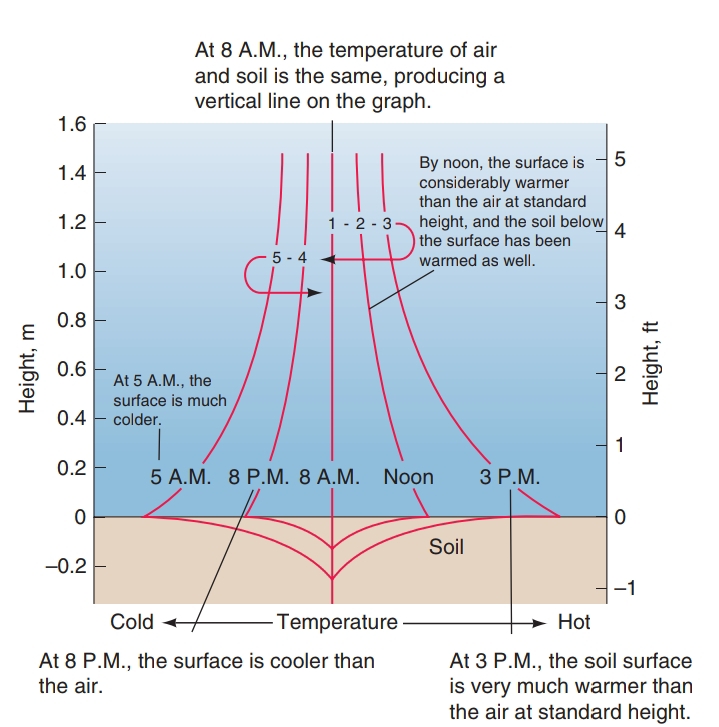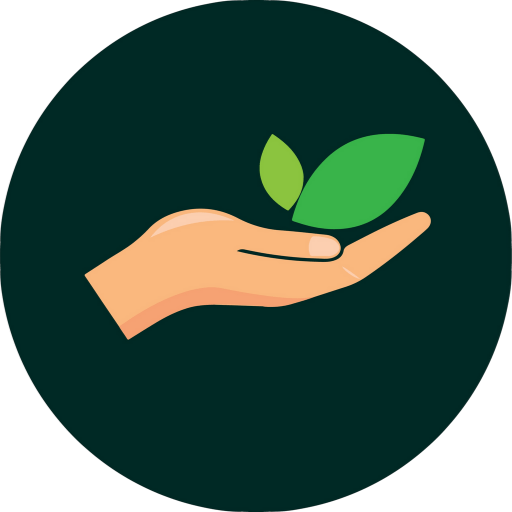This chapter focuses on air temperature —that is, the temperature of the air as observed at 1.2 m (4 ft) above the ground surface. Air temperature conditions many aspects of human life, from the clothing we wear to the fuel costs we pay. Air tem-perature and air tempera-ture cycles also act to select the plants and animals that make up the biological landscape of a region. And air temperature, along with precipitation, is a key deter-miner of climate.
Five important factors influence air temperature:
- Latitude. Daily and annual cycles of insolation vary systematically with latitude, causing air temperatures and air temperature cycles to vary as well. Yearly insolation decreases toward the poles, so less energy is available to heat the air. But because the seasonal cycle of insolation becomes more intense with latitude, high latitudes experience a much greater range in air temperatures throughout the year.
- Surface type. Urban air temperatures are generally higher than rural temperatures. City surface materials—asphalt, roofing shingles, stone, brick—hold little water, compared to the moist soil surfaces of rural areas and forests, so there is little cooling through evaporation. Urban materials are also darker and absorb a greater portion of the Sun’s energy than vegetation-covered surfaces. The same is true for areas of barren or rocky soil surfaces, such as those of deserts.
- Coastal or interior location. Locations near the ocean experience a narrower range of air temperatures than locations in continental interiors. Because water heats and cools more slowly than land, air temperatures over water are less extreme than temperatures overland. When air flows from water to land, a coastal loca-tion will feel the influence of the adjacent water.
- Elevation. Temperature decreases with elevation. At high elevation there is less atmosphere above the surface, and greenhouse gases provide a less effec-tive insulating blanket. More surface heat is lost to space. On high peaks, snow accumulates and remains longer. The reduced greenhouse effect also results in greater daily temperature variation.
- Atmospheric and oceanic circulations. Local tempera-tures can rise or fall rapidly when air from one region is brought into another. Temperatures of coastal regions can be influenced by warm or cold coastal currents. We will return to these factors in pages to come. But first, we will look at surface and air temperature in more detail.
Surface Temperature
Temperature is a familiar concept. It is a measure of the level of kinetic energy of the atoms in a substance, whether it is a gas, liquid, or solid. When a substance receives a flow of radiant energy, such as sunlight, the kinetic energy level increases, and its temperature rises. Similarly, if a substance loses energy by radiation, its temperature falls. This energy flow moves in and out of a solid or liquid substance at its surface —for example, the very thin surface layer of soil that actually absorbs solar shortwave radiation and radiates longwave radia-tion out to space.
The temperature of a surface is determined by the balance among the various energy flows that move across it. Net radiation —the balance between incoming shortwave radiation and outgoing longwave radiation—produces a radiant energy flow that can heat or cool a surface. During the day, incoming solar radiation normally exceeds outgoing longwave radiation, so the net radiation balance is positive and the surface warms. Energy flows through the surface into the cooler soil below. At night, net radiation is negative, and the soil loses energy as the surface temperature falls and the surface radiates longwave energy to space.

Energy may also move to or from a surface in other ways. Conduction describes the flow of sensible heat from a warmer substance to a colder one through direct contact. When energy flows into the soil from its warm surface during the day, it flows by conduction. At night, the energy is conducted back to the colder soil surface.
Latent heat transfer is also important. When water evaporates at a surface, it removes the energy stored in the change of state from liquid to vapor, thus cooling the surface. When water condenses at a surface, latent heat energy is released, warming the surface.
Another form of energy transfer is convection , in which energy is distributed in a fluid by mixing. If the surface is in contact with a fluid, such as a soil surface with air above, upward- and downward-flowing currents can act to warm or cool the surface.
Air Temperature
In contrast to surface temperature is air temperature, which is measured at a standard height of 1.2 m (4.0ft) above the ground surface. Air temperature can be quite different from surface temperature. When you walk across a parking lot on a clear summer day, you will notice that the pavement is a lot hotter than the air against the upper part of your body. In general, air temperatures above a surface reflect the same trends as ground surface temperatures, but ground temperatures are likely to be more extreme.
In the United States, temperature is still widely mea-sured and reported using the Fahrenheit scale. In this book, we use the Celsius temperature scale, which is the international standard. On the Celsius scale, the freezing point of water is 0°C and the boiling point is 100°C. Conversion formulas between these two scales are given below.

Air temperature measure-ments are made routinely at weather stations. Although some weather stations report temperatures hourly, most only report the maximum and minimum temperatures recorded dur-ing a 24-hour period. These are the most important values in observing long-term trends in temperature.

Temperature measure-ments are reported to governmental agencies charged with weather forecasting, such as the U.S. Weather Service or the Meteorological Service of Canada. These agencies typically make available daily, monthly, and yearly temperature statistics for each station using the daily maximum, minimum, and mean temperatures. The mean daily air temperature is defined as the average of the maximum and minimum daily values. The mean monthly air temperature is the average of mean daily tem-peratures in a month. These statistics, along with others such as daily precipitation, are used to describe the climate of the station and its surrounding area.
Temperatures Close to The Ground
Soil, surface, and air temperatures within a few meters of the ground change throughout the day.

The daily temperature variation is greatest just above the surface. The air temperature at standard height is far less variable. In the soil, the daily cycle becomes gradually less pronounced with depth, until we reach a point where daily temperature variations on the surface cause no change at all.
Useful External Links


